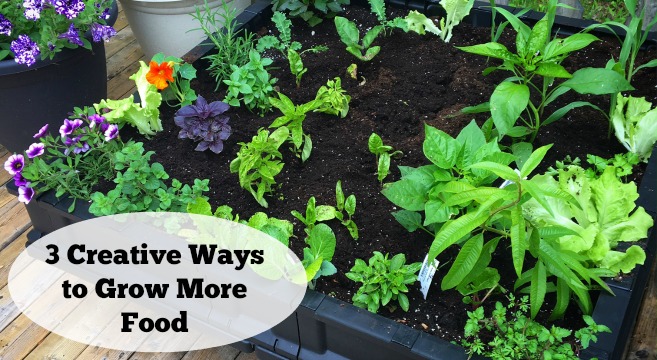This post may contain affiliate links. If you make a purchase through links on our site, we may earn a commission.
Let me get right to the point; you don’t need a big garden to grow more food. Even small space gardeners can boost yield by thinking creatively in the garden. To help you up your garden game, we’ve teamed up with Lee Valley, the go-to store for American and Canadian gardeners, to show you three creative ways to grow more food.
Vegepod Container Garden:
Deck and patio gardeners will love the Vegepod Container Garden, a well-designed system that allows intensive gardening in very small spaces. This instant garden is the perfect way for gardeners, including new food gardeners and families, to grow some of their own food. It measures 39-inches square and 10-inches high, allowing plenty of space for your favorite veggies, herbs, and edible flowers.

My Vegepod took about 30 minutes to put together and was then placed on my sunny back deck. I filled it with a combination of potting soil and compost to ensure it will be well-draining, but also retain moisture. Then came the fun part – planting! I chose compact varieties of peppers and eggplant, as well as an assortment of salad greens, herbs, and bee-friendly flowers.
There is an optional 18-inch tall steel stand that can be used to raise the Vegepod to a height of 31 inches, reducing the need to bend, kneel, or stoop.

5 Awesome features of the Vegepod:
- Reduce watering! It has a 8.5 gallon (32 litre) water reservoir that wicks moisture up into the soil when needed. It can reduce watering time by up to 80%.
- Pest control! It comes with a cool hinged top that can be covered with fitted mesh (included) that will allow sun and water to reach your crops but exclude a wide variety of pests.
- Multi-purpose use! The removable top also has a misting line that can be hooked up to a hose for easy watering. Perfect for starting seedlings or even taking cuttings of herbaceous herbs and perennials.
- Fall & winter harvesting! As a year-round vegetable gardener, I love that I can use the Vegepod as an instant cold frame when I cover the top with the (included) 12 mil thick PVC frost cover. It will take my deck garden from summer into fall and early winter.
- Weed-free! By using potting soil and aged compost, you control the soil quality and can eliminate the need to weed.

A DIY Lettuce Tower:
Growing vegetables vertically in an easy way to grow more food in less space. This vertical lettuce tower was created in an hour using an inexpensive laundry bin, some food-safe plastic, potting soil, and lettuce seedlings.

The materials:
- A wire laundry bin, with holes at least 2 inches across. This one cost $9.99 at a discount home decor store.
- A food-safe plastic sheet or bag
- Potting soil, the amount will depend on the size of your laundry bin
- Lettuce seedlings (I also added some loose-leaf Chinese cabbage and pansies)

6 Steps to making a lettuce tower:
Step 1 – Line the laundry bin with the plastic sheet or bag, poking holes in the bottom for drainage.
Step 2 – Fill the bin with pre-moistened potting soil, I used Pro-Mix.
Step 3 – Using a sharp knife, cut X’s into the plastic. This is where you will place the lettuce seedlings.
Step 4 – Hold a lettuce seeding by the rootball and push it through the plastic and into the potting soil. Make sure you have good contact with the soil, using your fingers to firm the soil around the rootball as much as possible. Repeat around the entire laundry bin.
Step 5 – Plant a few lettuce seedlings and some edible flowers at the top of the tower.
Step 6 – Water deeply with a gentle stream of water.

Continue to water your lettuce tower regularly. For very tall towers, a perforated PVC pipe can be placed in the middle of the bin for easy watering. Just be sure to insert it before you add the soil, holding the pipe in place until the bin is filled with the planting medium.

Bean or Cucumber Tunnels:
Growing vegetables vertically is smart gardening. Not only does it allow you to grow more food in less space, but it also helps prevent insect and disease problems, and adds beauty to the garden. When I redesigned my vegetable garden, I made sure to find space for at least three tunnels between the raised beds.
I made the tunnels from simple sheets of 8 foot long by 4 foot wide concrete reinforced mesh panels. I used two panels per tunnel, joined at the top with zip ties. To ensure they would be sturdy, the bottom of each panel was secured to the raised bed with a strip of wood.
For more details on the building of my tunnels, please check out my recent post, Vertical Vegetable Gardening.

A big thank you to Lee Valley for sponsoring this post. The Vegepod is available at Lee Valley stores across Canada, as well as on the Lee Valley website in both the US and Canada. To order a free Lee Valley catalog, or find your closest store, click here.
Do you have any creative ways to grow more food in your garden?




Leave a Reply